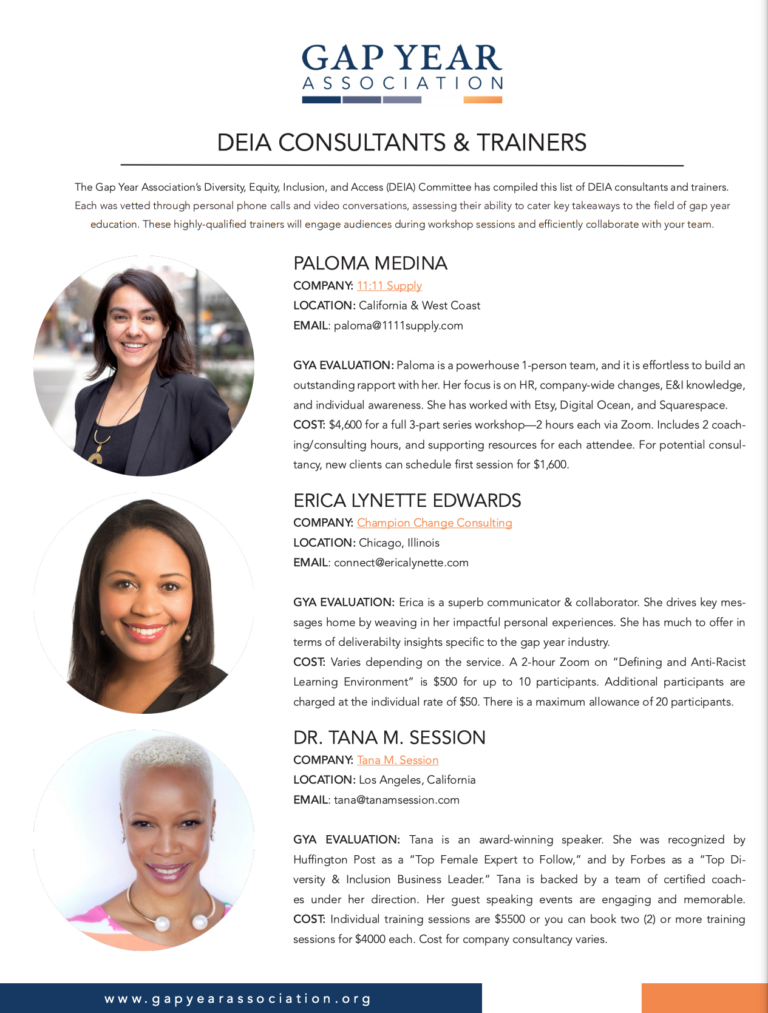Gap year experiences offer all students—regardless of socioeconomic background, race, cultural identity, gender identity, or romantic/sexual orientation—an opportunity to develop higher levels of emotional and cultural intelligence and to cultivate clarity around their sense of purpose in life.
However, GYA’s research suggests that a majority of gap year program participants are white, female students from middle and higher socioeconomic backgrounds. Students of color, first-generation college students, low-income students, migrant students, and male-identifying students continue to express interest in gap years but encounter barriers around equity and access.
Barriers to Taking a Gap Year:
The following six areas are the most common barriers for students when it comes to gap year participation:
Strategies to Support Diverse Student Populations
ECONOMIC
- Ask your college or university about financial aid
- Research program-specific scholarships or grants
- Research general scholarships or grants
- Research educational travel scholarships (e.g. GoOverseas, GoAbroad, Volunteer Forever)
- Partake in crowdfunding or personal fundraising (e.g. GoFundMe, Razoo, Fundly)
- Consider working with a Gap Year Consultant
REPRESENTATION AND VISIBILITY/FACULTY AND ADMINISTRATIVE SUPPORT
- Share! Write essays and circulate your stories through social media and beyond
- Participate in gap year alumni networks such as GYA’s Alum Committee, Student Members Facebook Group, etc.
- Be a mentor or a guide for prospective gap year students
- If you are a prospective gap year student, seek out alumni to share their experiences with you
- Check your college/university to see if they have a Gap Year Club for connecting with alumni; or, start your own!
FAMILY SUPPORT
- Contact gap year programs with lots of questions
- Ask how they support their underrepresented students
- Ask about the benefits of taking a gap year
- Talk to alumni of the program you’re considering or a family member of an alum
- Ask alumni about their initial concerns, or advice they would give to prospective gap year students
COMMUNITY AND SOCIAL SUPPORT after your gap year
- Communicate your experience to others in your community
- Explain why you decided to take a gap year, and why you would recommend one
- Share photos and videos of your gap year on social media
- Tell others about the benefits of your gap year, and how you plan to apply what you learned during your gap year to your life post gap year
- Consider presenting on your experience at schools or educational organizations
- Connect with local gap year communities to get more involved
- If you’re a prospective gap year student, seek out alumni through gap year program alumni networks and ask them many questions
PREJUDICE & DISCRIMINATION
- Ask gap year programs about their policies and procedures for responding to incidents of discrimination, bias, and micro-aggressions. Make sure the program offers plenty of support and protection. This would be a great topic to bring up with the alumni you speak with
- Ask for examples of what to expect in terms of racism, sexism, and LGBTQPIA2+ discrimination, or lack of mobility or accessibility
- If you plan to participate in a program overseas, ask about the laws in the countries you may visit, and how the program plans to help alleviate any mobility or discrimination challenges
- Talk with alumni who can share their first-hand experiences
- Ask alumni about their experiences with safety and discrimination, how to prepare for travel, and any other advice they would share
- Make a strategy with your gap year program on how to stay safe and protected
- Make sure you know what to do and whom to contact if something should happen
ECONOMIC
- Consider offering new and/or expanded student scholarships
- Offer diversity-focused grants for specifically underrepresented students
REPRESENTATION, VISIBILITY, AND ADMINISTRATIVE SUPPORT
- Reach out to alumni from diverse backgrounds to share their experiences
- Without tokenizing, highlight the stories of underrepresented students on social media and in marketing materials
- Consider creating volunteer positions or student internships that engage alumni as mentors and guides for prospective students. However, note that unpaid work favors students of more privileged socio-economic backgrounds. Thus, offering paid internships can help increase the diversity in your alumni mentor network.
- Consider offering a cohort program so students can create a network with peers from similar backgrounds
FAMILY SUPPORT
- Foster and sustain robust alumni networks
- Host subgroups for alumni with specific identities (e.g. students of color, LGBTQPIA+ students, students with disabilities, etc.)
- Make these networks available to prospective students so they can build relationships
- Consider creating a network just for parents or family members
- Have materials available in different languages
- Consider offering programs of varying lengths, as shorter programs may be better suited for students with familial responsibilities
COMMUNITY AND SOCIAL SUPPORT
- Share alumni stories with media that is dynamic and accessible (e.g. Capitalize the first letter of each word in hashtags to accommodate people using text readers
- Without tokenizing, include underrepresented students in marketing materials and content, depicting diverse scenes without tokenizing
- Post interactive media on your website (e.g. photos, videos, soundbites, etc.) and make re-sharing easy
- Consider designing cohort-based programs (or chapters) that cater to specific student needs, such as affinity groups for students of color
PREJUDICE & DISCRIMINATION
- Be transparent: systemic racism and discrimination exist everywhere and it is everyone’s responsibility to acknowledge and work with their personal and organizational biases
- Share how mobility for students with disabilities will be limited in many places
- Tell students what to expect and provide them with tools for responding to it
- Have clear and transparent policies and procedures that protect and prepare students
- Train your staff with fast-thinking and compassionate response techniques to incidents of discrimination
- Connect applicants and participants with alumni who can share first-hand experiences of what to expect
ECONOMIC
- Research and identify diverse gap year programs
- Research and identify gap year programs that offer grants and scholarships
- Share helpful resources on financial aid with students
- Consider offering gap year scholarships for future participants or for returning alumni
- Create clear policies and procedures for student deferral during a gap year
REPRESENTATION, VISIBILITY, AND ADMINISTRATIVE SUPPORT
- Identify students who would benefit from gap years
- Provide staff and faculty of color to mentor students of color
- Seek out leaders of color on campus to help raise awareness of representation in gap years
- Identify members of your campus community that can serve as advocates for representation in gap years
- Create clubs and/or opportunities for underrepresented students to socialize and connect with one another
- Have clear deferral policies for admissions and scholarship awards for students who choose to take a gap years
FAMILY SUPPORT
- Identify gap year programs with strong alumni networks
- Connect families to gap year organizations and consultants and alumni to answer questions
- Train staff to better understand barriers for underrepresented students and families
COMMUNITY AND SOCIAL SUPPORT
- Collect diverse stories from students who are gap year alumni
- Share these stories widely with your campus network and on social media
- Use visually-engaging mediums and encourage students to repost your content
- Consider creating campus clubs for gap year alumni so students can more easily connect and create communities of support
PREJUDICE & DISCRIMINATION
- Research gap year organizations that demonstrate understanding and support for underrepresented students; request copies of their policies and procedures
- Ask organizations about prevention measures, and their response processes should discrimination occur
DEIA Consultants & Trainers
If you represent a gap year program interested in improving Diversity, Equity, Inclusion, and Access within your organization and among your clients/participants, consider hiring a GYA-vetted DEIA Consultant. A special thanks to the hard work of Brynna Rao, GYA board member and DEIA Committee member, for developing this valuable directory.
GYA's DEIA Committee
GYA’s Diversity, Equity, Inclusion, and Access (DEIA) Committee is dedicated to improving DEIA practices across the field of gap year education. Visit the committee’s webpage to learn more about their leadership, past and ongoing projects, and ways to get involved.
The Gap Year Association stands in solidarity with Black Lives Matter. The statement Black lives matter goes without saying, and we recognize the importance and vitality of Black Lives Matter as a movement. Click the button below for our full statement.


